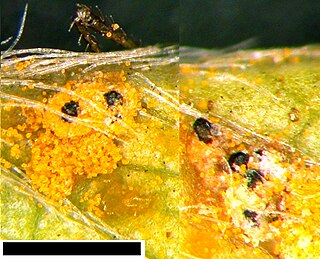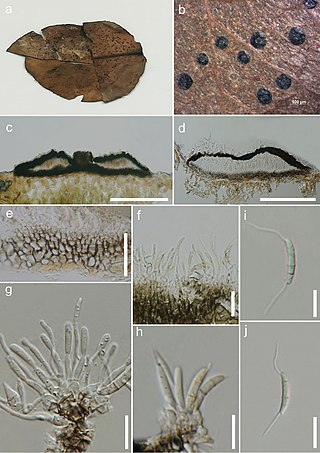Related Research Articles

The Hypocreales are an order of fungi within the class Sordariomycetes. In 2008, it was estimated that it contained some 237 genera, and 2647 species in seven families. Since then, a considerable number of further taxa have been identified, including an additional family, the Stachybotryaceae. Wijayawardene et al. in 2020 added more families and genera to the order. According to the Catalog of Life, As of April 2021 the Hypocreales contains 6 families, 137 genera, and 1411 species. Hyde et al. (2020a) listed 14 families under Hypocreales, while, Wijayawardene et al. (2022) accepted 15 families in the order, where Cylindriaceae was additionally added. Earlier, Hyde et al. (2020a) had placed Cylindriaceae in class Xylariomycetidae. Samarakoon et al. (2022) agreed. Hence, Cylindriaceae should have been excluded from Hypocreales and placed in Xylariomycetidae. Xiao et al. (2022) recently introduced a new family Polycephalomycetaceae to Hypocreales.

The Nectriaceae comprise a family of fungi in the order Hypocreales. It was circumscribed by brothers Charles and Louis René Tulasne in 1865. In 2020, an Outline of fungi was produced and listed 70 genera and about 1,336 species.
The fungal genus Truncatella in the family Sporocadaceae, and in the Amphisphaeriales order, includes plant pathogens such as Truncatella laurocerasi.

Pleosporaceae is a family of sac fungi. They are pathogenic to humans or saprobic on woody and dead herbaceous stems or leaves.

The Botryosphaeriales are an order of sac fungi (Ascomycetes), placed under class Dothideomycetes. Some species are parasites, causing leaf spot, plant rot, die-back or cankers, but they can also be saprophytes or endophytes. They occur world-wide on many hosts. For example, in China, infections related to Botryosphaeriales have been recorded on numerous hosts such as grapes, Caragana arborescens,Cercis chinensis, Eucalyptus, Chinese hackberry, blueberry, forest trees, and various other woody hosts.
The Roussoellaceae are a family of fungi in the order Pleosporales. As accepted by Wijayawardene et al. 2020;

The Phaeosphaeriaceae are a family of fungi in the order Pleosporales. Species in the family have a cosmopolitan distribution, and are generally nectrotrophic or saprobic on a wide range of plants.

The Massarinaceae are a family of fungi in the order Pleosporales. Although taxa have a cosmopolitan distribution, they are better-known in temperate regions. They are thought to be saprobic in wood and bark; some species are weak pathogens.
Broomella is a genus of fungi in the family Sporocadaceae.

Pestalotiopsis is a genus of ascomycete fungi in the Sporocadaceae family.

Seiridium is a genus of plant pathogens in the family Sporocadaceae.

Monochaetia is a genus of fungi in the family Sporocadaceae. Species in the genus are typically plant parasites and saprobes, and cause leaf spot diseases on various hosts.
Seimatosporium is a fungus genus within the family Sporocadaceae.

The Amphisphaeriales are an order of fungi within the class Sordariomycetes and subclass Xylariomycetidae.

The Sporocadaceae are a family of fungi, that was formerly in the order Xylariales. It was placed in the Amphisphaeriales order in 2020.

Sporocadus is a genus of plant pathogens in the family Sporocadaceae.

Discosia is a genus of plant pathogens in the family Sporocadaceae.
Pseudopestalotiopsis is a genus of plant pathogens in the family Sporocadaceae.
Sarcostroma is a genus of fungi in the family Sporocadaceae. Most species of this genus are saprobes, endophytes or pathogens on leaves.

Neocamarosporium is a genus of ascomycete fungi, as accepted by Wijayawardene et al. 2020. The species are typically halotolerant, being commonly found in saline environments like in saline water, hypersaline soils and especially in association with halophytes.
References
- 1 2 3 4 Liu, F.; Bonthond, G.; Groenewald, J.Z.; Cai, L.; Crous, P.W. (March 2019). "Sporocadaceae, a family of coelomycetous fungi with appendage-bearing conidia". Studies in Mycology. 92: 287–415. doi:10.1016/j.simyco.2018.11.001. PMC 6298422 . PMID 30584265.
- ↑ Wijayawardene, Nalin; Hyde, Kevin; Al-Ani, Laith Khalil Tawfeeq; Somayeh, Dolatabadi; Stadler, Marc; Haelewaters, Danny; et al. (2020). "Outline of Fungi and fungus-like taxa". Mycosphere. 11: 1060–1456. doi: 10.5943/mycosphere/11/1/8 .
- ↑ Senanayake, Indunil C.; Maharachchikumbura, Sajeewa S. N.; Hyde, Kevin D.; Bhat, Jayarama D.; Jones, E. B. Gareth; McKenzie, Eric H. C.; Dai, Dong Qin; Daranagama, Dinushani A.; Dayarathne, Monika C.; Goonasekara, Ishani D.; Konta, Sirinapa; Li, Wen Jing; Shang, Qiu Ju; Stadler, Marc; Wijayawardene, Nalin N.; Xiao, Yuan Pin; Norphanphoun, Chada; Li, Qirui; Liu, Xing Zhong; Bahkali, Ali H.; Kang, Ji Chuan; Wang, Yong; Wen, Ting Chi; Wendt, Lucile; Xu, Jian Chu; Camporesi, Erio (2015). "Towards unraveling relationships in Xylariomycetidae (Sordariomycetes)". Fungal Diversity. 73 (1): 73–144. doi:10.1007/s13225-015-0340-y. S2CID 256070746.
- ↑ Farr, D. F.; Rossman, A. Y. (2019). "Fungal Databases". Syst. Mycol. Microbiol. Lab., ARS, USDA. Retrieved 21 February 2023.
- 1 2 Wang, Shu-Ren; Zhang, Haixiao; Chen, Yun-Ze; Zhang, Yun-Di; Li, Da-Bo; Huang, Ying; Zhang, Guocai; Yang, Jing (2 February 2022). "First Report of Black Spot Needle Blight of Pinus sylvestris var. mongolica Litv. Caused by Heterotruncatella spartii in China". Plant Dis. doi: 10.1094/PDIS-12-21-2667-PDN . PMID 35108070.
- ↑ "Heterotruncatella F.Liu, L.Cai & Crous, 2018". www.gbif.org. Retrieved 22 February 2023.
- ↑ "Heterotruncatella - Search Page". www.speciesfungorum.org. Species Fungorum. Retrieved 22 February 2023.